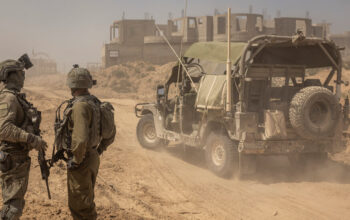Luggage for your vacations comes in all shapes and sizes, from family-sized suitcases you check in at the airport to smaller wheeled cases you can squeeze in as airline carry-on. Then there are duffel bags, which are great for simply stuffing in everything you can and hurling into the back of a car. But with so many brands, each offering a dazzling variety of luggage options, it’s difficult to know which ones are actually worth your time and, crucially, your hard-earned money.
To save you some effort, we’ve done the hard work for you, bringing together some of the best choices around and putting them through their paces to make sure they’re up to scratch. Everything on this list has been tested by us and if it didn’t impress, it didn’t make the list. We’ll be keeping this list updated over time as new models are added or existing entrants are removed from sale.
So let’s dive in.

 \n ","topic":"","ttag":"","searchDim":"article-body|listicle|image","variant":"article-body|listicle|image","viewguid":"","event":"listicle|image|1","correlationId":"","_destCat":"https:\/\/www.americantourister.co.uk\/airconic-spinner-4-wheels-77cm-deep-ocean\/128188-6613.html?cgid=A693#start=1","productName":"American Tourister Airconic Spinner 77","formatType":"IMAGE","location":"LIST","position":1,"sku":"","dwLinkTag":"article-body|listicle|image","selector":"#article-body #listicle-91bb5c92-2730-48d1-9270-40bc9506aa33 .itemImage"}}” rel=”noopener nofollow” target=”_blank”>
\n ","topic":"","ttag":"","searchDim":"article-body|listicle|image","variant":"article-body|listicle|image","viewguid":"","event":"listicle|image|1","correlationId":"","_destCat":"https:\/\/www.americantourister.co.uk\/airconic-spinner-4-wheels-77cm-deep-ocean\/128188-6613.html?cgid=A693#start=1","productName":"American Tourister Airconic Spinner 77","formatType":"IMAGE","location":"LIST","position":1,"sku":"","dwLinkTag":"article-body|listicle|image","selector":"#article-body #listicle-91bb5c92-2730-48d1-9270-40bc9506aa33 .itemImage"}}” rel=”noopener nofollow” target=”_blank”>
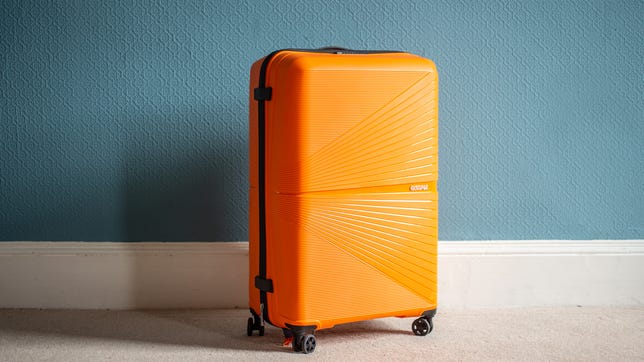

Andrew Lanxon/CNET
With its 101-liter internal capacity, the American Tourister Airconic Spinner offers a capacious size that makes it great for families on longer trips. It zips open down the middle, opening up into two halves that allows you to pack more thoughtfully — your clothes in one side, the kids’ clothes in the other.
Empty, it weighs only 3.2 kilograms (7 pounds) meaning it adds very little of its own weight to your luggage. Despite that, it still feels well-built, with a semi-firm outer shell that offers protection to the contents, but with enough flex to absorb the knocks and bumps it’ll get in baggage handling.
The wheels are quite small which was noticeable when wheeling it across thick carpet, but on smoother surfaces it glides well in either its upright mode on all four wheels or being dragged with handle on just two wheels. It has a water-resistant zipper, a built-in TSA-approved lock and it’s available in an array of vibrant hues to help it stand out when it comes round on the luggage carousel.

 \n ","topic":"","ttag":"","searchDim":"article-body|listicle|image","variant":"article-body|listicle|image","viewguid":"","event":"listicle|image|2","correlationId":"","_destCat":"https:\/\/www.samsonite.co.uk\/stackd-spinner-75cm–pastel-yellow\/134640-1661.html","productName":"Samsonite Stackd 75","formatType":"IMAGE","location":"LIST","position":2,"sku":"","dwLinkTag":"article-body|listicle|image","selector":"#article-body #listicle-43e0858f-a8af-4608-b88d-15deee0d0d8b .itemImage"}}” rel=”noopener nofollow” target=”_blank”>
\n ","topic":"","ttag":"","searchDim":"article-body|listicle|image","variant":"article-body|listicle|image","viewguid":"","event":"listicle|image|2","correlationId":"","_destCat":"https:\/\/www.samsonite.co.uk\/stackd-spinner-75cm–pastel-yellow\/134640-1661.html","productName":"Samsonite Stackd 75","formatType":"IMAGE","location":"LIST","position":2,"sku":"","dwLinkTag":"article-body|listicle|image","selector":"#article-body #listicle-43e0858f-a8af-4608-b88d-15deee0d0d8b .itemImage"}}” rel=”noopener nofollow” target=”_blank”>
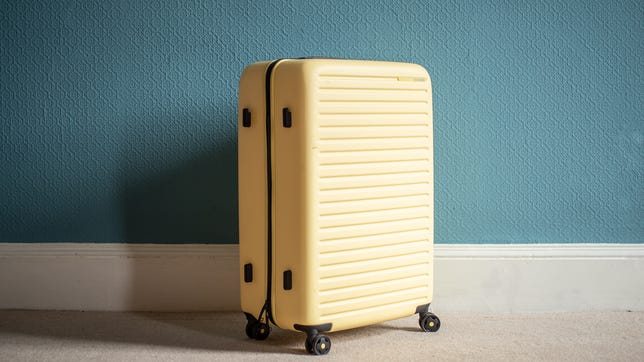

Andrew Lanxon/CNET
When I first started testing the Samsonite Stackd I thought it felt a bit plasticky and might not put up with much punishment from over-enthusiastic luggage handlers. I needn’t have worried though — it put up with my abusive tests admirably, with none of the fractures or breakages I was concerned about.
Its 96-liter internal volume makes this another good option for family traveling, or for anyone traveling solo for extended periods. Its polycarbonate construction means it’s light and its four wheels provide a smooth motion, on rough ground, carpet or cobbled streets — or as smooth as it can be on cobbled streets, anyway.
It has a TSA-approved lock, and the retractable handle is comfortable to haul along the road and feels like it can put up with some punishment as you drag it up staircases or onto trains.

 \n ","topic":"","ttag":"","searchDim":"article-body|listicle|image","variant":"article-body|listicle|image","viewguid":"","event":"listicle|image|3","correlationId":"","_destCat":"https:\/\/gomatic.co.uk\/products\/navigator-carry-on-37l","productName":"Nomatic (Gomatic) Navigator wheeled carry on 37L","formatType":"IMAGE","location":"LIST","position":3,"sku":"","dwLinkTag":"article-body|listicle|image","selector":"#article-body #listicle-3aa7a118-92f5-4dfe-8268-41e7b8b32777 .itemImage"}}” rel=”noopener nofollow” target=”_blank”>
\n ","topic":"","ttag":"","searchDim":"article-body|listicle|image","variant":"article-body|listicle|image","viewguid":"","event":"listicle|image|3","correlationId":"","_destCat":"https:\/\/gomatic.co.uk\/products\/navigator-carry-on-37l","productName":"Nomatic (Gomatic) Navigator wheeled carry on 37L","formatType":"IMAGE","location":"LIST","position":3,"sku":"","dwLinkTag":"article-body|listicle|image","selector":"#article-body #listicle-3aa7a118-92f5-4dfe-8268-41e7b8b32777 .itemImage"}}” rel=”noopener nofollow” target=”_blank”>
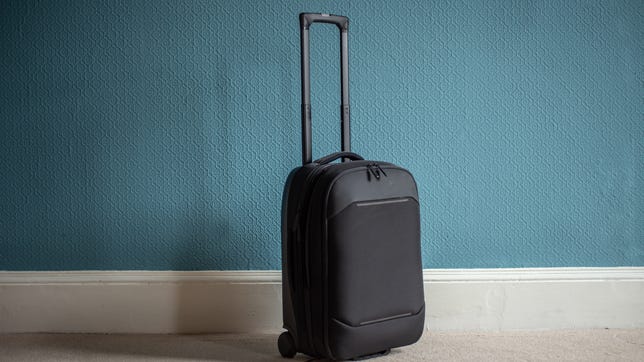

Andrew Lanxon/CNET
Sold under the brand Gomatic in the UK, Nomatic’s Navigator wheeled case is a superb all-rounder piece of travel luggage. It’s sturdy, with a hard back that protects it from knocks and bumps with a softer top that can be expanded from 37 liters to 44 liters. That makes it a flexible option as a one-size-fits-all case for short weekend trips or longer excursions.
Nomatic calls it a “carry-on” and indeed at 14 by 9 by 22-inches it fits just about within British Airways’ carry-on restrictions. However other more budget airlines would not accept this size, so make sure you double-check the restrictions with whatever airline you’re flying with and that you’re including the expanded size, if you’re using it.
It has separate zip compartments for your laptop and other gadgets, the outer material is water resistant and both the handle and wheels feel robust and capable of handling anything a demanding travel schedule can throw at it.

 \n ","topic":"","ttag":"","searchDim":"article-body|listicle|image","variant":"article-body|listicle|image","viewguid":"","event":"listicle|image|4","correlationId":"","_destCat":"https:\/\/www.ospreyeurope.com\/shop\/gb_en\/osprey-transporter-hardside-hybrid-36l-2022","productName":"Osprey Transporter Hardside Hybrid 36L","formatType":"IMAGE","location":"LIST","position":4,"sku":"","dwLinkTag":"article-body|listicle|image","selector":"#article-body #listicle-393add08-b7dc-4fe9-a106-e2fb68ae8866 .itemImage"}}” rel=”noopener nofollow” target=”_blank”>
\n ","topic":"","ttag":"","searchDim":"article-body|listicle|image","variant":"article-body|listicle|image","viewguid":"","event":"listicle|image|4","correlationId":"","_destCat":"https:\/\/www.ospreyeurope.com\/shop\/gb_en\/osprey-transporter-hardside-hybrid-36l-2022","productName":"Osprey Transporter Hardside Hybrid 36L","formatType":"IMAGE","location":"LIST","position":4,"sku":"","dwLinkTag":"article-body|listicle|image","selector":"#article-body #listicle-393add08-b7dc-4fe9-a106-e2fb68ae8866 .itemImage"}}” rel=”noopener nofollow” target=”_blank”>
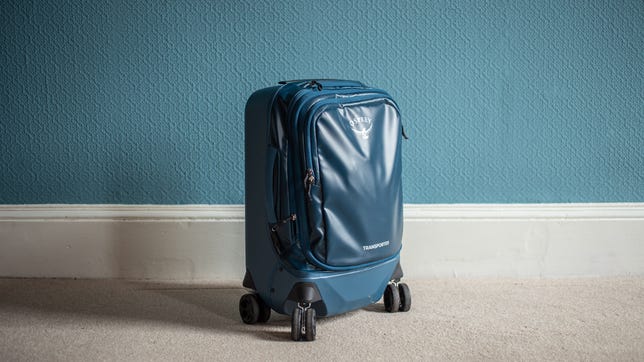

Andrew Lanxon/CNET
Like the Nomatic Navigator, Osprey’s Transporter combines a hard polycarbonate bottom with a soft top, designed to give a “best of both worlds” approach to durability and flexibility. And it works well here, with the soft material offering water resistance and can expand well to cram more stuff in.
Its size makes it carry-on compatible with some airlines (make sure to check the specific restrictions with the airline you’re using) and its 3-kilogram (6.5-pound) weight means you won’t feel overly bogged down with it. Until you load your heavy goods into it, at least.
I like too that it’s made with recycled materials and its electric blue color should stand out nicely on the luggage carousel. Its four wheels are large enough to cope with bumps in the road, but I found that if you go too fast the wheels start to wobble like an errant shopping cart, which is worth keeping in mind. Otherwise it feels well put together and survived our tumble tests admirably.

 \n ","topic":"","ttag":"","searchDim":"article-body|listicle|image","variant":"article-body|listicle|image","viewguid":"","event":"listicle|image|5","correlationId":"","_destCat":"https:\/\/horizn-studios.com\/en\/collections\/luggage\/cabin\/products\/model-h\/dark-olive-vegan-hard-shell\/#gallery-image-5","productName":"Horizn Studios H5 Cabin Luggage 35L","formatType":"IMAGE","location":"LIST","position":5,"sku":"","dwLinkTag":"article-body|listicle|image","selector":"#article-body #listicle-dafa52f5-795b-4c8f-a61d-426b4e636c34 .itemImage"}}” rel=”noopener nofollow” target=”_blank”>
\n ","topic":"","ttag":"","searchDim":"article-body|listicle|image","variant":"article-body|listicle|image","viewguid":"","event":"listicle|image|5","correlationId":"","_destCat":"https:\/\/horizn-studios.com\/en\/collections\/luggage\/cabin\/products\/model-h\/dark-olive-vegan-hard-shell\/#gallery-image-5","productName":"Horizn Studios H5 Cabin Luggage 35L","formatType":"IMAGE","location":"LIST","position":5,"sku":"","dwLinkTag":"article-body|listicle|image","selector":"#article-body #listicle-dafa52f5-795b-4c8f-a61d-426b4e636c34 .itemImage"}}” rel=”noopener nofollow” target=”_blank”>
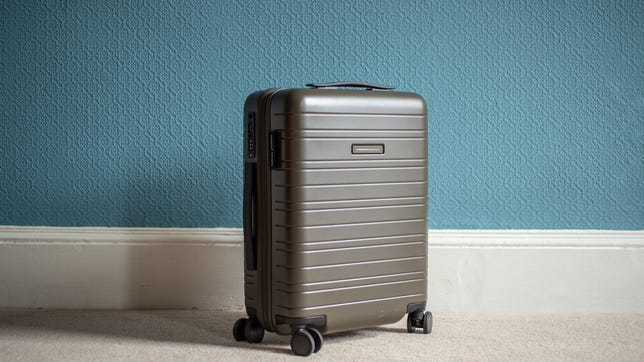

Andrew Lanxon/CNET
With a 35-liter internal volume, the Horizn Studios H5 case is compatible with many airlines’ carry-on restrictions, making it a great option for shorter trips — though always double-check the restrictions of the airline you’re flying with. It’s lightweight, but its polycarbonate shell is sturdy, with enough flex in it to put up with severe knocks and bumps while in transit.
Its four wheels offer a smooth glide across carpet or rough outdoor terrain and its retractable handle feels reassuringly able to put up with abuse. It’s made from a range of recycled materials too, it’s 100% vegan and made in a way that eliminates 99% of waste during production.
The H5 comes in a standard or “Smart” version, the latter including a battery pack hidden beneath the handle that lets you plug your phone in if you need to charge on the move. It’s a handy addition, but personally I’d just go for the standard model and get my own charger that I can take anywhere.
You’ll also find a TSA-approved combination lock and comfortable carry handles on the side and top. I love its smart look that wouldn’t look out of place on a vacation with your mates or being wheeled into a fancy city-center business hotel.

 \n ","topic":"","ttag":"","searchDim":"article-body|listicle|image","variant":"article-body|listicle|image","viewguid":"","event":"listicle|image|6","correlationId":"","_destCat":"https:\/\/shop.samsonite.com\/luggage\/checked-luggage\/proxis-extra-large-spinner\/141848XXXX.html","productName":"Samsonite Proxis 81","formatType":"IMAGE","location":"LIST","position":6,"sku":"","dwLinkTag":"article-body|listicle|image","selector":"#article-body #listicle-4e381bea-ab43-4958-96bc-d05df740bbe3 .itemImage"}}” rel=”noopener nofollow” target=”_blank”>
\n ","topic":"","ttag":"","searchDim":"article-body|listicle|image","variant":"article-body|listicle|image","viewguid":"","event":"listicle|image|6","correlationId":"","_destCat":"https:\/\/shop.samsonite.com\/luggage\/checked-luggage\/proxis-extra-large-spinner\/141848XXXX.html","productName":"Samsonite Proxis 81","formatType":"IMAGE","location":"LIST","position":6,"sku":"","dwLinkTag":"article-body|listicle|image","selector":"#article-body #listicle-4e381bea-ab43-4958-96bc-d05df740bbe3 .itemImage"}}” rel=”noopener nofollow” target=”_blank”>
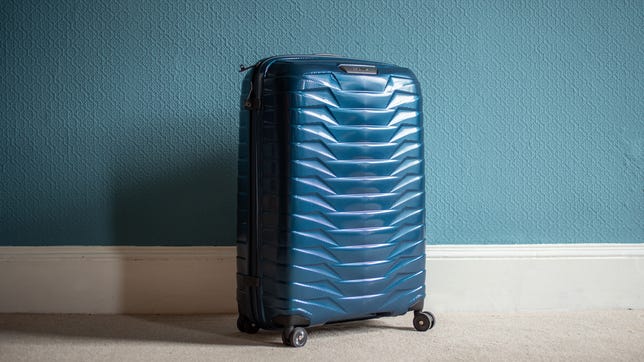

Andrew Lanxon/CNET
Samsonite’s Proxis four-wheeled suitcase is the most expensive on this list, and that’s largely down to the material it’s made from. Samsonite calls it Roxkin and it’s apparently designed to be hard-wearing while remaining light.
And certainly at only 3.5 kilograms it’s on the light side for a case with a whopping 125-liter internal volume. Its sheer size makes it a great option for longer vacations or family trips where you really want to try and cram everything into just the one case.
As for its hardiness, it survived our tumble tests admirably, with no visible dents after multiple falls down stairs. The great-looking petrol blue outer did show some scuff marks, so keep that in mind if you like your luggage to always look pristine (why would you?) but I have no concerns about its ability to put up with abuse from baggage handlers.
It’s got a built-in TSA-approved lock and its four casters, while quite small, still manage to offer a smooth ride over thick carpet and rough ground.

 \n ","topic":"","ttag":"","searchDim":"article-body|listicle|image","variant":"article-body|listicle|image","viewguid":"","event":"listicle|image|7","correlationId":"","_destCat":"https:\/\/www.amazon.com\/Journey-Hytta-Split-duffel-50L\/dp\/B09VXJLQLG\/","productName":"Db Hytta Split Duffel 50L","formatType":"IMAGE","location":"LIST","position":7,"sku":"","dwLinkTag":"article-body|listicle|image","selector":"#article-body #listicle-aef769f7-c037-4045-9b8c-2780a3348f6d .itemImage"}}” rel=”noopener nofollow” target=”_blank”>
\n ","topic":"","ttag":"","searchDim":"article-body|listicle|image","variant":"article-body|listicle|image","viewguid":"","event":"listicle|image|7","correlationId":"","_destCat":"https:\/\/www.amazon.com\/Journey-Hytta-Split-duffel-50L\/dp\/B09VXJLQLG\/","productName":"Db Hytta Split Duffel 50L","formatType":"IMAGE","location":"LIST","position":7,"sku":"","dwLinkTag":"article-body|listicle|image","selector":"#article-body #listicle-aef769f7-c037-4045-9b8c-2780a3348f6d .itemImage"}}” rel=”noopener nofollow” target=”_blank”>
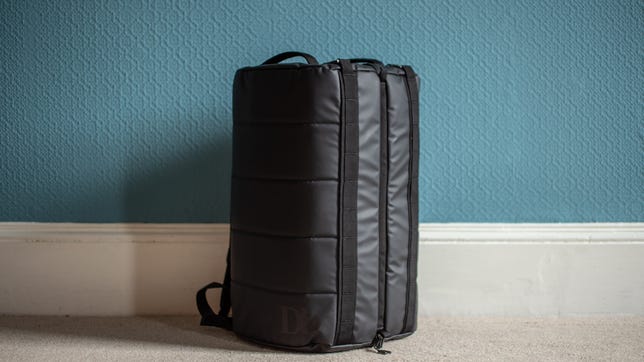

Andrew Lanxon/CNET
I’ve taken Db’s Hytta Duffel on multiple weekend breaks and road trips recently and it’s performed superbly on them all. It’s essentially a duffel bag, with carry handles on the top and straps on the back so you can wear it as a backpack. But there’s a zip all round the middle that lets it open into two halves like a butterfly. Each side has its own zip cover.
Rather than it just being one big storage area for everything like most holdalls, this two-sided approach makes it much easier to separate out your packing and keep things organized while you’re away. Perhaps it’s to separate clean clothes from dirty ones, or one side for clothes, one side for toiletries and other accessories. The choice is yours.
It’s made from durable recycled materials that feel like they’ll probably last forever and its total 50-liter volume is capacious enough for a long weekend at least. It’s compatible with most airlines’ carry-on restrictions too.

 \n ","topic":"","ttag":"","searchDim":"article-body|listicle|image","variant":"article-body|listicle|image","viewguid":"","event":"listicle|image|8","correlationId":"","_destCat":"https:\/\/uk.yeti.com\/products\/panga-75-duffel","productName":"Yeti Panga 75L waterproof duffel","formatType":"IMAGE","location":"LIST","position":8,"sku":"","dwLinkTag":"article-body|listicle|image","selector":"#article-body #listicle-1f60de9e-2d87-465e-9071-53b2c03f75a5 .itemImage"}}” rel=”noopener nofollow” target=”_blank”>
\n ","topic":"","ttag":"","searchDim":"article-body|listicle|image","variant":"article-body|listicle|image","viewguid":"","event":"listicle|image|8","correlationId":"","_destCat":"https:\/\/uk.yeti.com\/products\/panga-75-duffel","productName":"Yeti Panga 75L waterproof duffel","formatType":"IMAGE","location":"LIST","position":8,"sku":"","dwLinkTag":"article-body|listicle|image","selector":"#article-body #listicle-1f60de9e-2d87-465e-9071-53b2c03f75a5 .itemImage"}}” rel=”noopener nofollow” target=”_blank”>
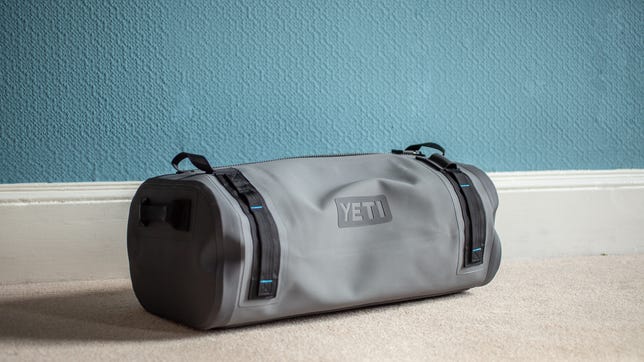

Andrew Lanxon/CNET
While many bags out there call themselves water-resistant and a few even claim to shirk enough liquid to qualify as waterproof, few companies take it as far as Yeti. The Panga is actually waterproof enough to be fully submersible. That means not a single drop of liquid will get inside it when it’s properly zipped up, which also means it’s impossible to deflate when you’ve zipped it up when it’s empty.
Its waterproof nature means this is a bag that’s aimed squarely at those of you looking for a rugged outdoor holdall that can put up with whatever your active nature-loving lifestyle can throw at it. Camping in the snow? No problem. Backpacking via canoe? Shove your clothes in, zip it up and throw it on the boat.
The rubberised outer fabric feels hard-wearing (as you’d hope) and you’ll find strengthened nylon loops on the outside for you to lash it to your boat so even if you capsize, your precious bag won’t go floating off downstream. It all feels well designed and while it’s probably not the ideal bag for a long weekend in Paris (unless you’re swimming in the Seine), it’s a superb option if you need a bag to put up with your wilderness adventures.
How we test our luggage
In an ideal world we’d expense flights to the best holiday destinations simply to put our luggage through the sort of real-world tests that you’d do yourself. Our budgets not being in the tens of thousands, we have to find more appropriate ways to simulate those situations at home.
First off, we fill the cases up with a mixture of heavy and soft items and zip them up. We walk them around inside our homes, across hardwood floors, thick carpets, thin rugs — exactly the sort of surfaces you’d find in your own home and inside the various hotels, Airbnb rooms and guest houses you’ll find on your travels. Then we throw them down the stairs. Not because we’re annoyed at them, but because this is a great way of simulating the sort of brutal treatment the cases will likely get from airport baggage handlers.
Cases are frequently broken by baggage handlers being too rough, with snapped wheels being all too common. So we drop them on their wheels from all angles again and again. And then again. We pull on them and twist them. We put pressure on the handle. Can it support our weight and can it put up with being dragged around in a bad mood when your flight was delayed and you missed dinner service at your hotel?
We take them outside, still full of heavy items, and drag them over sidewalk paving stones, along old cobbled streets and up and down kerbs. Do they wobble? Do the wheels rattle? Do the handles bend? These are all the things we look out for. Finally we look close up at the zips and materials to check for any signs of loose stitching or other manufacturer defects that suggest that quality control could be better.
If they don’t survive the tests, they don’t make the list.
